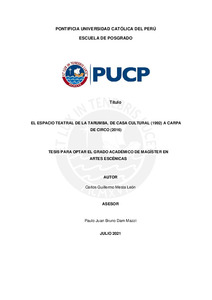| dc.contributor.advisor | Dam Mazzi, Juan Pablo Bruno | |
| dc.contributor.author | Mesta León, Carlos Guillermo | |
| dc.date.accessioned | 2021-10-06T17:14:59Z | |
| dc.date.available | 2021-10-06T17:14:59Z | |
| dc.date.created | 2021 | |
| dc.date.issued | 2021-10-06 | |
| dc.identifier.uri | http://hdl.handle.net/20.500.12404/20553 | |
| dc.description.abstract | La violencia extrema que apareció en el Perú en la década de los 80 y que venía
acumulándose desde décadas anteriores, condicionó los temas y las prácticas de teatro
de ese momento histórico. Sumado a esto, los lugares teatrales en el Perú y en el caso
específico de Lima, hasta los años 80, eran muy pocos y tenían una configuración
convencionalmente a la Italiana o eran auditorios adaptados para el uso teatral. En el
marco de la violencia y de esta arquitectura teatral aparece La Tarumba, que adquiere
la casa cultural Cocolido, en el año 1992 y la convierte en Circo de Cámara o Circo
Teatro. Este nuevo lugar significó la respuesta a lo violento y a la tradición. Fue
absolutamente no convencional. Con este lugar se produce la ruptura con todas las
formas teatrales existentes anteriormente y se configura como un antecedente de lo que
sería la Carpa de Circo. Esta arquitectura no fue producto de un diseño basado en un
programa arquitectónico común. Tampoco estuvo sujeta a repetir las formas
convencionales de un teatro a la italiana o de un circo clásico. El caso de La Tarumba
es un hito sin precedentes donde la remodelación fue en realidad una transformación
de las prácticas teatrales del grupo en una arquitectura teatral propia.
No fue un diseño imaginando formas y espacios. Fue un diseño imaginando
movimientos.
La Tarumba dio relevancia al actor performador para que en complicidad con la mirada
de un arquitecto pudieran llegar a diseñar una nueva arquitectura coherente con sus
prácticas, pero no solamente tomando en cuenta su labor artística sino también su labor
social de proyección hacia su comunidad.
Establecerse para desarrollar sus prácticas artísticas y su circo social fueron estrategias
fundamentales para fortalecer las capacidades que necesitaron para construir su propio
cuerpo arquitectónico articulado con su entorno urbano.
Más aún, la itinerancia es tanto el eje vital de La Tarumba, que actualmente sus
directores tienen la prognosis de una nueva arquitectura teatral más allá de las formas
de la carpa de circo, que recoge tanto su filosofía como su experiencia. | es_ES |
| dc.description.abstract | The extreme violence that appeared in Peru in the 1980s and that had been
accumulating since previous decades, conditioned the themes and theater practices of
that historical moment. Added to this, the theatrical venues in Peru and in the specific
case of Lima, until the 1980s, were very few and had a conventionally Italian
configuration or were auditoriums adapted for theatrical use. In the framework of violence
and this theatrical architecture, La Tarumba appears, which acquires the Cocolido
cultural house in 1992 and turns it into a Chamber Circus or Theater Circus. This new
place meant the response to violence and tradition. It was absolutely unconventional.
With this place there is a break with all previously existing theatrical forms and it is
configured as an antecedent of what would be the Circus Tent. This architecture was not
the product of a design based on a common architectural program. Nor was it subject to
repeating the conventional forms of an Italian theater or a classical circus. The case of
La Tarumba is an unprecedented milestone where the remodeling was actually a
transformation of the group's theatrical practices into its own theatrical architecture.
It was not a design imagining shapes and spaces. It was a design imagining movements.
La Tarumba gave relevance to the performing actor so that in complicity with the gaze
of an architect they could come to design a new architecture consistent with their
practices, but not only taking into account their artistic work but also their social work of
projection towards their community.
Establishing themselves to develop their artistic practices and their Social Circus were
fundamental strategies to strengthen the capacities they needed to build their own
architectural body articulated with their urban environment.
Furthermore, itinerancy is so much the vital axis of La Tarumba that its directors currently
have the prognosis of a new theatrical architecture beyond the shapes of the circus tent,
which includes both their philosophy and their experience. | es_ES |
| dc.language.iso | spa | es_ES |
| dc.publisher | Pontificia Universidad Católica del Perú | es_ES |
| dc.rights | info:eu-repo/semantics/openAccess | es_ES |
| dc.rights.uri | http://creativecommons.org/licenses/by/2.5/pe/ | * |
| dc.subject | Circo--Perú | es_ES |
| dc.subject | Gestión cultural--Perú | es_ES |
| dc.subject | Teatro peruano--Historia | es_ES |
| dc.title | El espacio teatral de La Tarumba. De casa cultural (1992) a carpa de circo (2016) | es_ES |
| dc.type | info:eu-repo/semantics/masterThesis | es_ES |
| thesis.degree.name | Magíster en Artes Escénicas | es_ES |
| thesis.degree.level | Maestría | es_ES |
| thesis.degree.grantor | Pontificia Universidad Católica del Perú. Escuela de Posgrado. | es_ES |
| thesis.degree.discipline | Artes Escénicas | es_ES |
| renati.advisor.dni | 08275537 | |
| renati.advisor.orcid | https://orcid.org/0000-0002-5129-4788 | es_ES |
| renati.author.dni | 08215697 | |
| renati.discipline | 215047 | es_ES |
| renati.juror | Santistevan de Noriega, Luis Alfonso | |
| renati.juror | Dam Mazzi, Juan Pablo Bruno | |
| renati.juror | Calderón Urbina, Karen Virginia | |
| renati.level | https://purl.org/pe-repo/renati/level#maestro | es_ES |
| renati.type | https://purl.org/pe-repo/renati/type#tesis | es_ES |
| dc.publisher.country | PE | es_ES |
| dc.subject.ocde | https://purl.org/pe-repo/ocde/ford#6.04.04 | es_ES |






